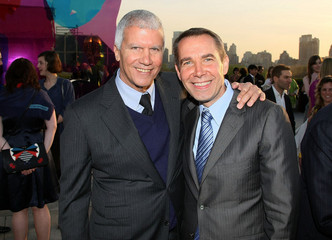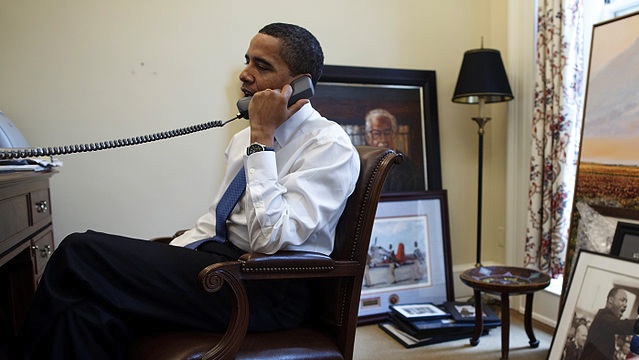Power Surge: The Art Review 100

Scrolling through the 2010 Power 100 of Art Review, I almost immediately had two reactions. First, I’m not on it! (Bloggers get little to no respect.) Second, so many of the artists (and only 18 of the 100 are artists) are either unfamiliar to me or, maybe worse, too familiar. Any list is suspect purely by nature. The makers of this list claim that it’s “[f]irst and foremost,… a guide to the general trends, networks and forces that shape the artworld.” What such lists really provide is something for people like me to talk about. What I find myself talking about is the way the list reflects the true source of power—in the hands of gallerists, curators, and art fair directors and, disturbingly so, not in the hands of artists or critics. What does that power surge to those who aren’t creating or critiquing mean for art today?
Larry Gagosian (shown above with Jeff Koons) sits comfortably at the top of the list, rising from the fifth slot he occupied last year. The listmakers admit Gagosian’s rampant arrogance is “not appealing, but it’s the behaviour of power in excelsis, when all competition has vanished from the rearview.” If Gagosian’s truly lapped the field, then maybe the field needs to begin following his lead. Swiss curator Hans Ulrich Obrist, Swiss gallerist Iwan Wirth, German gallerist David Zwirner, and MoMA Director Glenn D. Lowry round out the rest of the top five. Like the art world it aims to reflect, the list circles the globe in terms of occupants. Europe and modern art still dominate the art world, usually in some intimate combination. Seeing the name of Charles Saatchi languishing at number 81 reminded me of how far the once mighty have fallen. Although bloggers find no love, the e-flux Website did garner the 16th position, mainly on the strength of acting as the hub of electronic communication in the art world.
I found it slightly dismaying that The New York Times senior art critic Roberta Smith slipped in at number 80 when more gifted critics such as Christopher Knight or Peter Schjeldahl can’t crack the century mark. It would also have been nice to see some academics, such as Michael Fried, Rosalind Krauss, or James Elkins, find a place. Such voices help the art world of today measure up to the accomplishments of the past by shining a new light on them.
Even more dismaying might be the appearance of the first artist at number 13—Chinese artist Ai Weiwei. As the listmakers hint at, Ai’s political activity as a resister against the repressive Chinese government may have won him the position more than his actual art. More familiar names follow in the persons of Bruce Nauman (17), Cindy Sherman (27), Marina Abramovic (35), Takashi Murakami (39), Gerhard Richter (55), Anish Kapoor (62), and Neo Rauch (69). Glory hounds Jeff Koons and Damien Hirst came in 47 and 53 on the list, with Koons plummeting all the way from 13 last year. I smiled at the inclusion of Maurizio Cattelan at 68. Cattelan’s attention grabbing middle-finger sculpture almost single-handedly (single-fingerly?) won him that spot. A slew of other artists I know barely or not at all round out the field: Mike Kelley (26), Franz West (29), Peter Fischli and David Weiss (31), Tino Sehgal (44), Rirkrit Tiravanija (88), Wolfgang Tillmans (89), and the artists’ consortium known as the Bruce High Quality Foundation (89). I’m sure they’re all talented artists, and I freely confess a less than encyclopedic knowledge of contemporary art, but none of those names resounds with the familiarity of Koons, Hirst, or even Murakami in the modern art market. I wonder how many casual art fans could name any of those artists.
It would be nice if these artists represent the new wave of art that makes a dent in the cultural zeitgeist. But I sincerely doubt it, not based on their failures or lackings but on the undentability of culture today by an individual artist who fails to play the insider game and prostitute themselves in the process. Sure, people like Abramovic enjoy a greater profile today thanks to retrospectives, but the dues she paid in the years leading up to the international renown more than compensate for any game-playing today, especially as her insider activities help promote performance art itself as much as her personally. I’d like to see more artists—and more artists of aesthetic rather than economic significance—on the top 100, and, dare I say it, more critics than gallerists and museum directors. Trends should come from the creators and those who help push them to create. Of course, museums critique as well, but the economic choices they face force biases—just try to think of big museums as critical voices the next time they line up a big, fat, crowd-pleasing Impressionist show for the thousandth time. A power surge in that direction may be what it takes to energize art today and make it relevant to the world again.





